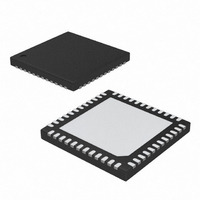MAX17017GTM+ Maxim Integrated Products, MAX17017GTM+ Datasheet - Page 20

MAX17017GTM+
Manufacturer Part Number
MAX17017GTM+
Description
IC PWR SUPPLY CONTROLLER 48TQFN
Manufacturer
Maxim Integrated Products
Datasheet
1.MAX17017GTM.pdf
(31 pages)
Specifications of MAX17017GTM+
Applications
Power Supply Controller
Voltage - Input
5.5 ~ 28 V
Operating Temperature
-40°C ~ 105°C
Mounting Type
Surface Mount
Package / Case
48-TQFN Exposed Pad
Input Voltage
5.5 V to 24 V
Operating Temperature Range
- 40 C to + 105 C
Mounting Style
SMD/SMT
Duty Cycle (max)
300 uA
Supply Voltage Range
3V To 5V, 5.5V To 28V
Digital Ic Case Style
TQFN
No. Of Pins
48
Termination Type
SMD
No. Of Channels
4
Rohs Compliant
Yes
Filter Terminals
SMD
Leaded Process Compatible
Yes
Lead Free Status / RoHS Status
Lead free / RoHS Compliant
Current - Supply
-
Voltage - Supply
-
Lead Free Status / Rohs Status
Lead free / RoHS Compliant
Quad-Output Controller for
Low-Power Architecture
The MAX17017 uses a light-load pulse-skipping operat-
ing mode for all switching regulators. The switching
regulators turn off the low-side MOSFETs when the cur-
rent sense detects zero inductor current. This keeps the
inductor from discharging the output capacitors and
forces the switching regulator to skip pulses under
light-load conditions to avoid overcharging the output.
When pulse-skipping mode is enabled, the on-time of
the step-down controller terminates when the output
voltage exceeds the feedback threshold and when the
current-sense voltage exceeds the idle-mode current-
sense threshold. Under light-load conditions, the on-
time duration depends solely on the idle-mode
current-sense threshold. This forces the controller to
source a minimum amount of power with each cycle. To
avoid overcharging the output, another on-time cannot
begin until the output voltage drops below the feed-
back threshold. Since the zero-crossing comparator
prevents the switching regulator from sinking current,
the MAX17017 switching regulators must skip pulses.
Therefore, the controller regulates the valley of the out-
put ripple under light-load conditions.
In skip mode, an inherent automatic switchover to PFM
takes place at light loads. This switchover is affected by
a comparator that truncates the low-side switch on-time
at the inductor current’s zero crossing. The zero-crossing
Table 1. FREQ Table
20
SELECT
______________________________________________________________________________________
SYNC
LDO5
GND
REF
PIN
Automatic Pulse-Skipping Crossover
f
Idle-Mode Current-Sense Threshold
Light-Load Operation Control
SWA
FREQUENCY
SWITCHING
0.5 x f
250kHz
375kHz
500kHz
AND f
SYNC
SWC
REG A AND REG C
SOFT-START TIME
REG A: 1200/f
REG C: 900/f
REG C: 3.6ms
REG C: 2.4ms
REG C: 1.8ms
REG A: 4.8ms
REG A: 3.2ms
REG A: 2.4ms
—
SWC
SWA
BLANKING
1500/f
STARTUP
TIME
6ms
4ms
3ms
—
comparator senses the inductor current during the off-
time. For regulator A, once V
the 1mV zero-crossing current-sense threshold, the com-
parator turns off the low-side MOSFET (DLA pulled low).
For regulators B and C, once the current through the low-
side MOSFET drops below 100mA, the zero-crossing
comparator turns off the low-side MOSFET.
The minimum idle-mode current requirement causes
the threshold between pulse-skipping PFM operation
and constant PWM operation to coincide with the
boundary between continuous and discontinuous
inductor-current operation (also known as the critical
conduction point). The load-current level at which
PFM/PWM crossover occurs (I
to half the idle-mode current threshold (see the
Electrical Characteristics table for the idle-mode thresh-
olds of each regulator). The switching waveforms can
appear noisy and asynchronous when light loading
causes pulse-skipping operation, but this is a normal
operating condition that results in high light-load effi-
ciency. Trade-offs in PFM noise vs. light-load efficiency
are made by varying the inductor value. Generally, low
inductor values produce a broader efficiency vs. load
curve, while higher values result in higher full-load effi-
ciency (assuming that the coil resistance remains fixed)
and less output voltage ripple. Penalties for using high-
er inductor values include larger physical size and
degraded load-transient response (especially at low
input-voltage levels).
SWA
FREQUENCY
SWITCHING
500kHz
750kHz
1MHz
f
f
SYNC
SWB
SOFT-START
1800/f
REG B
CSPA
3.6ms
2.4ms
1.8ms
TIME
LOAD(SKIP)
—
SWB
- V
CSNA
) is equivalent
BLANKING
STARTUP
3000/f
drops below
TIME
6ms
4ms
3ms
—
SWB











